Spending
Spending 2020–21 to 2025–26
The following graph presents planned (voted and statutory spending) over time.
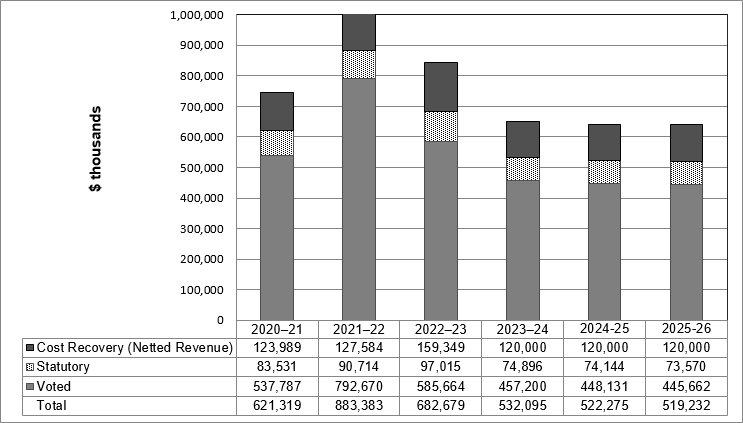
Description - Purpose-based engagement
| 2020–21 | 2021–22 | 2022–23 | 2023–24 | 2024-25 | 2025-26 | |
|---|---|---|---|---|---|---|
| Cost Recovery (Netted Revenue) | 123,989 | 127,584 | 159,349 | 120,000 | 120,000 | 120,000 |
| Statutory | 83,531 | 90,714 | 97,015 | 74,896 | 74,144 | 73,570 |
| Voted | 537,787 | 792,670 | 585,664 | 457,200 | 448,131 | 445,662 |
| Total | 621,319 | 883,383 | 682,679 | 532,095 | 522,275 | 519,232 |
Budgetary performance summary for core responsibilities and internal services (dollars)
The "Budgetary performance summary for core responsibilities and internal services" table presents the budgetary financial resources allocated for Statistics Canada's core responsibilities and for internal services.
| Core responsibilities and internal services | 2022–23 Main Estimates | 2022–23 planned spending | 2023–24 planned spending | 2024–25 planned spending | 2022–23 total authorities available for use | 2020–21 actual spending (authorities used) | 2021–22 actual spending (authorities used) | 2022–23 actual spending (authorities used) |
|---|---|---|---|---|---|---|---|---|
| Statistical information | 616,663,357 | 616,663,357 | 579,311,471 | 571,978,435 | 754,356,616 | 666,463,788 | 920,977,524 | 731,447,169 |
| Internal services | 80,030,892 | 80,030,892 | 72,783,788 | 70,296,376 | 111,048,632 | 78,844,148 | 89,989,424 | 110,581,024 |
| Total gross expenditures | 696,694,249 | 696,694,249 | 652,095,259 | 642,274,811 | 865,405,248 | 745,307,936 | 1,010,966,948 | 842,028,193 |
| Respendable revenue | -120,000,000 | -120,000,000 | -120,000,000 | -120,000,000 | -159,349,013 | -123,989,068 | -127,583,773 | -159,349,013 |
| Total net expenditures | 576,694,249 | 576,694,249 | 532,095,259 | 522,274,811 | 706,056,235 | 621,318,868 | 883,383,175 | 682,679,180 |
Statistics Canada is funded by two sources: direct parliamentary appropriations and cost-recovery activities. It has the authority to generate $120 million annually in respendable revenue related to two streams: statistical surveys and related services, and custom requests and workshops. If exceeded, a request can be made to increase the authority, as was the case in the last few years.
In recent years, respendable cost-recovery revenue has contributed $120 million to $159 million annually to the agency's total resources. A large portion of this respendable revenue comes from federal departments to fund specific statistical projects. Respendable revenue increased in 2022–23 because of additional work associated with extra demands following the slowdown during the pandemic and the 2021 Census.
Spending fluctuations between the years shown in the graph and table above were mainly caused by the Census Program. Activity for this program peaked in 2021–22 when the 2021 Census of Population and the 2021 Census of Agriculture were conducted and drops in 2022–23 and 2023–24 as these activities wind down. This pattern is typical for the agency because of the cyclical nature of the Census Program. Funding for the 2026 Census of Population and the 2026 Census of Agriculture is not reflected, amplifying the decrease in the overall statistical information funding.
In addition, funding received for new initiatives from Budget 2021 is decreasing from 2022–23 to 2023–24 and will remain relatively the same in 2024–25.
The difference between 2022–23 actual spending and 2022–23 total authorities available for use is largely attributable to how the agency strategically manages its investments. The agency leverages the operating budget carry-forward mechanism to manage the cyclical nature of program operations and investments in the agency's strategic priorities.
Internal services spending from 2020–21 to 2022–23 includes resources from temporary funding related to an initiative approved in 2018–19 to migrate the agency's infrastructure to the cloud. The decrease in funding for outer years is largely attributable to ongoing funding related to cloud expenditures not yet secured and the agency's investment planning cycle. Investment funding from past years will come to an end in future years, while new investment decisions will be finalized only later in the year.
2022–23 Budgetary actual gross spending summary (dollars)
The following table reconciles gross planned spending with net spending for 2022–23.
| Core responsibilities and internal services | 2022–23 actual gross spending | 2022–23 actual revenues netted against expenditures | 2022–23 actual net spending (authorities used) |
|---|---|---|---|
| Statistical information | 731,447,169 | -159,349,013 | 572,098,156 |
| Internal services | 110,581,024 | 0 | 110,581,024 |
| Total gross expenditures | 842,028,193 | -159,349,013 | 682,679,180 |
Statistics Canada generated $159 million in respendable revenue from the sale of statistical products and services.
Human resources
The "Human resources summary for core responsibilities and internal services" table presents the full-time equivalents (FTEs) allocated to each of Statistics Canada's core responsibilities and to internal services.
Human resources summary for core responsibilities and internal services
| Core responsibilities and internal services | 2020–21 actual full-time equivalents | 2021–22 actual full-time equivalents | 2022–23 planned full-time equivalents | 2022–23 actual full-time equivalents | 2023–24 planned full-time equivalents | 2024–25 planned full-time equivalents |
|---|---|---|---|---|---|---|
| Statistical information | 6,099 | 7,186 | 5,889 | 7,005 | 5,415 | 5,389 |
| Internal services | 684 | 713 | 659 | 833 | 610 | 584 |
| Total gross expenditures | 6,783 | 7,899 | 6,548 | 7,838 | 6,025 | 5,973 |
| Respendable revenue | -1,340 | -1,542 | -1,181 | -1,795 | -1,189 | -1,189 |
| Total net expenditures | 5,443 | 6,357 | 5,367 | 6,043 | 4,836 | 4,784 |
Similar to trends seen in planned spending, changes in full-time equivalents from year to year are largely explained by the cyclical nature of the Census Program. Activity peaked in 2021–22, when the 2021 Census of Population and 2021 Census of Agriculture were conducted, and decreases thereafter as these activities wind down. Funding for the 2026 Census of Population, the 2026 Census of Agriculture and the cloud is not reflected, amplifying the decrease in overall full-time equivalents in future years.
Expenditures by vote
For information on Statistics Canada's organizational voted and statutory expenditures, consult the Public Accounts of Canada.
Government of Canada spending and activities
Information on the alignment of Statistics Canada's spending with Government of Canada's spending and activities is available in GC InfoBase.
Financial statements and financial statements highlights
Financial statements
Statistics Canada's financial statements (unaudited) for the year ended March 31, 2023, are available on the department's website.
The agency uses the full accrual accounting method to prepare and present its annual financial statements, which are part of the departmental result reporting process. However, spending authorities presented in the previous sections of this report remain on an expenditure basis. A reconciliation between the bases of reporting is available in Note 3 of the financial statements.
Financial statement highlights
| Financial information | 2022–23 planned results | 2022–23 actual results | 2021–22 actual results | Difference (2022–23 actual results minus 2022–23 planned results) | Difference (2022– 23 actual results minus 2021–22 actual results) |
|---|---|---|---|---|---|
| Total expenses | 830,619,454 | 950,829,557 | 1,098,855,896 | 120,210,103 | -148,026,339 |
| Total revenues | 120,000,000 | 159,106,926 | 127,990,099 | 39,106,926 | 31,116,827 |
| Net cost of operations before government funding and transfers | 710,619,454 | 791,722,631 | 970,865,797 | 81,103,177 | -179,143,166 |
The 2022–23 planned results information is provided in Statistics Canada's Future-Oriented Statement of Operations and notes for 2022–23. The assumptions underlying the forecasts were made before the completion of the 2021–22 fiscal year.
The net cost of operations before government funding and transfers was $791.7 million, a decrease of $179.1 million (22.6%) from $970.9 million in 2021–22, mainly because of the decrease in expenses related to the cyclical nature of the 2021 Census Program, for which activities peaked in 2021–22.
Actual versus planned
The difference between actual and planned net costs for 2022–23 is $81.1 million (11.4%). Expenses were $120 million higher than anticipated. A large portion of the increase is attributable to additional cost-recovery work associated with extra demands following the slowdown during the pandemic and the 2021 Census. It is also attributable to funding that was carried forward or reprofiled from 2021–22, allowing the agency to meet the needs of its cyclical programs and to invest in its integrated strategic plans, technology, new data sources, cutting-edge statistical methods and frameworks. In addition, funding received from the fiscal framework for the ratification of certain collective agreements contributed. These elements contributed to additional employee benefit plan spending. The increases were partially offset by budget carried forward to 2023–24.
Revenues were $31.1 million higher than anticipated, mainly because of an increase in additional cost-recovery work associated with extra demands following the slowdown during the pandemic and the 2021 Census.
For more information on the distribution of expenses by program and type, see the two charts below.
Gross expenditures by core responsibility
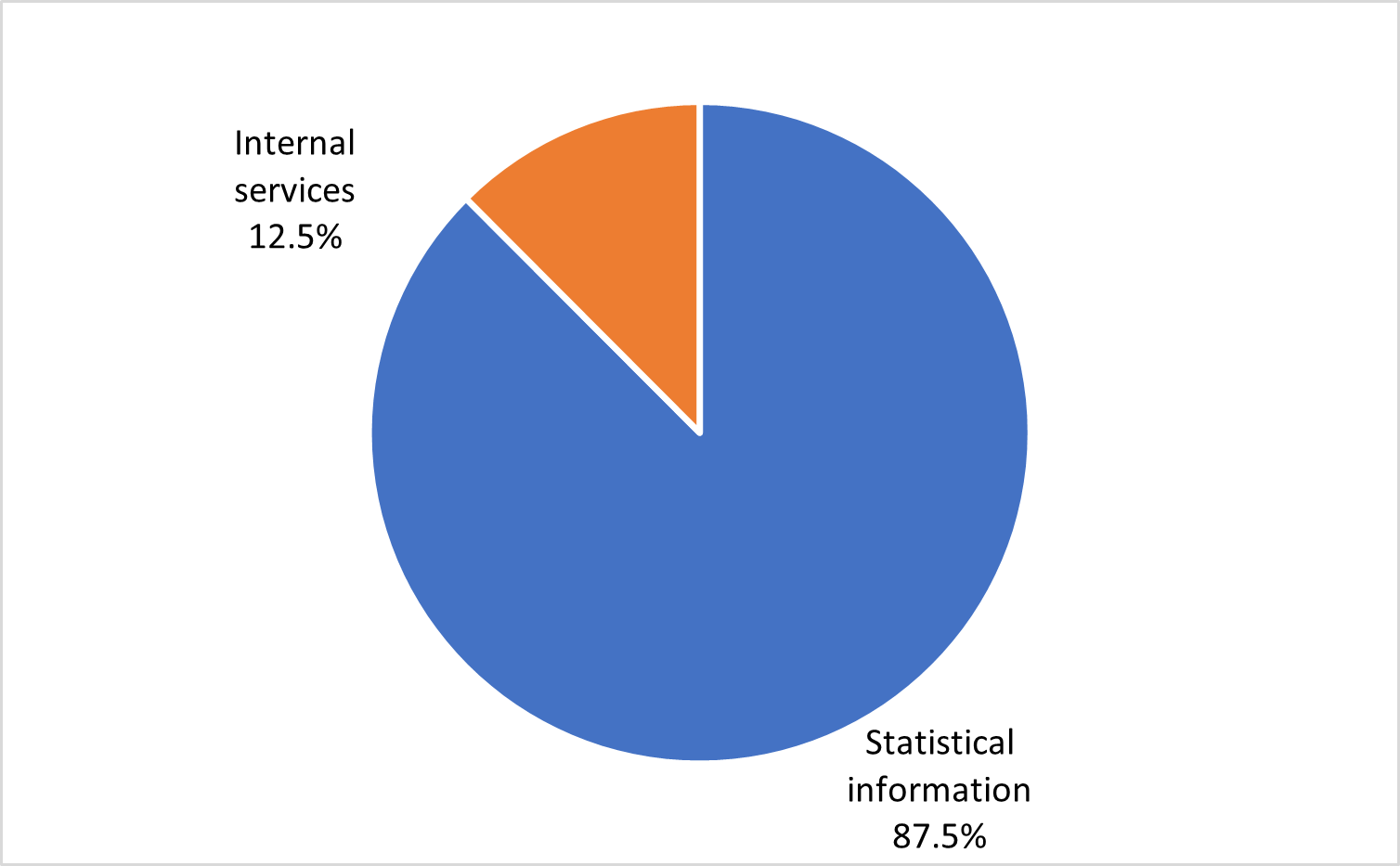
Total expenses, including services provided without charge by federal government departments, were $950.8 million in 2022–23. These expenses comprised $832.2 million (87.5%) for statistical information and $118.6 million (12.5%) for internal services.
Gross expenditures by type
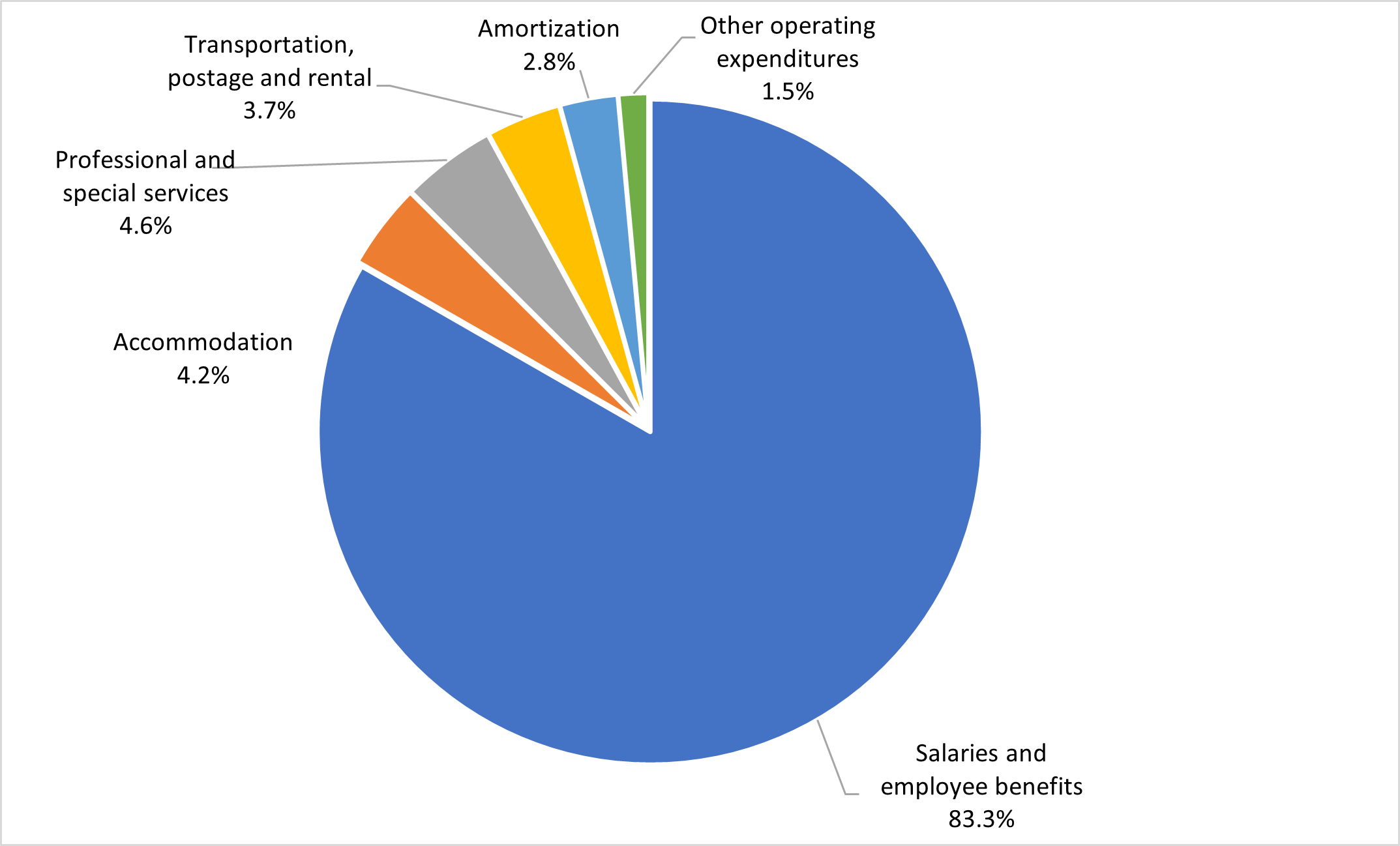
Statistics Canada spent $950.8 million in 2022–23. These expenses mainly comprised $792 million (83.3%) for salaries and employee benefits; $43.7 million (4.6%) for professional and special services; $39.7 million (4.2%) for accommodation; $34.8 million (3.7%) for transportation, postage and rental; and $26.8 million (2.8%) for amortization. Other operating expenditures comprised $13.8 million (1.5%) for communication and printing, repairs and maintenance, materials and supplies, etc.
| Financial information | 2022–23 | 2021–22 | Difference (2022–23 minus 2021–22) |
|---|---|---|---|
| Total net liabilities | 143,659,490 | 142,525,338 | 1,134,152 |
| Total net financial assets | 68,883,213 | 67,079,045 | 1,804,168 |
| Departmental net debt | 74,776,277 | 75,446,293 | -670,016 |
| Total non‑financial assets | 155,767,323 | 170,908,816 | -15,141,493 |
| Departmental net financial position | 80,991,046 | 95,462,523 | -14,471,477 |
The 2022–23 planned results information is provided in Statistics Canada's Future-Oriented Statement of Operations and notes for 2022–23. The departmental net financial position was $81 million at the end of 2022–23, a decrease of $14.5 million from $95.5 million in 2021–22.
Total net liabilities
The increase in total liabilities of $1.1 million is mainly attributable to an increase in accounts payable and accrued liabilities related to employer contributions to employee benefit plans and accrued salaries and wages, offset by a decrease in accounts payable to external parties, as well as a decrease in employee future benefits related to severance benefits.
Total net financial assets
The increase in total net financial assets of $1.8 million is mainly attributable to an increase in the amount due from the Consolidated Revenue Fund to discharge accounts payable and accrued liabilities. This is offset by a decrease in accounts receivable and advances.
Total non-financial assets
The decrease in total non-financial assets of $15.1 million is mainly attributable to a reduction in software acquisitions, an increase in write-offs and adjustments for internally developed software.
For more information on the distribution of the balances in the statement of financial position, see the two charts below.
Assets by type
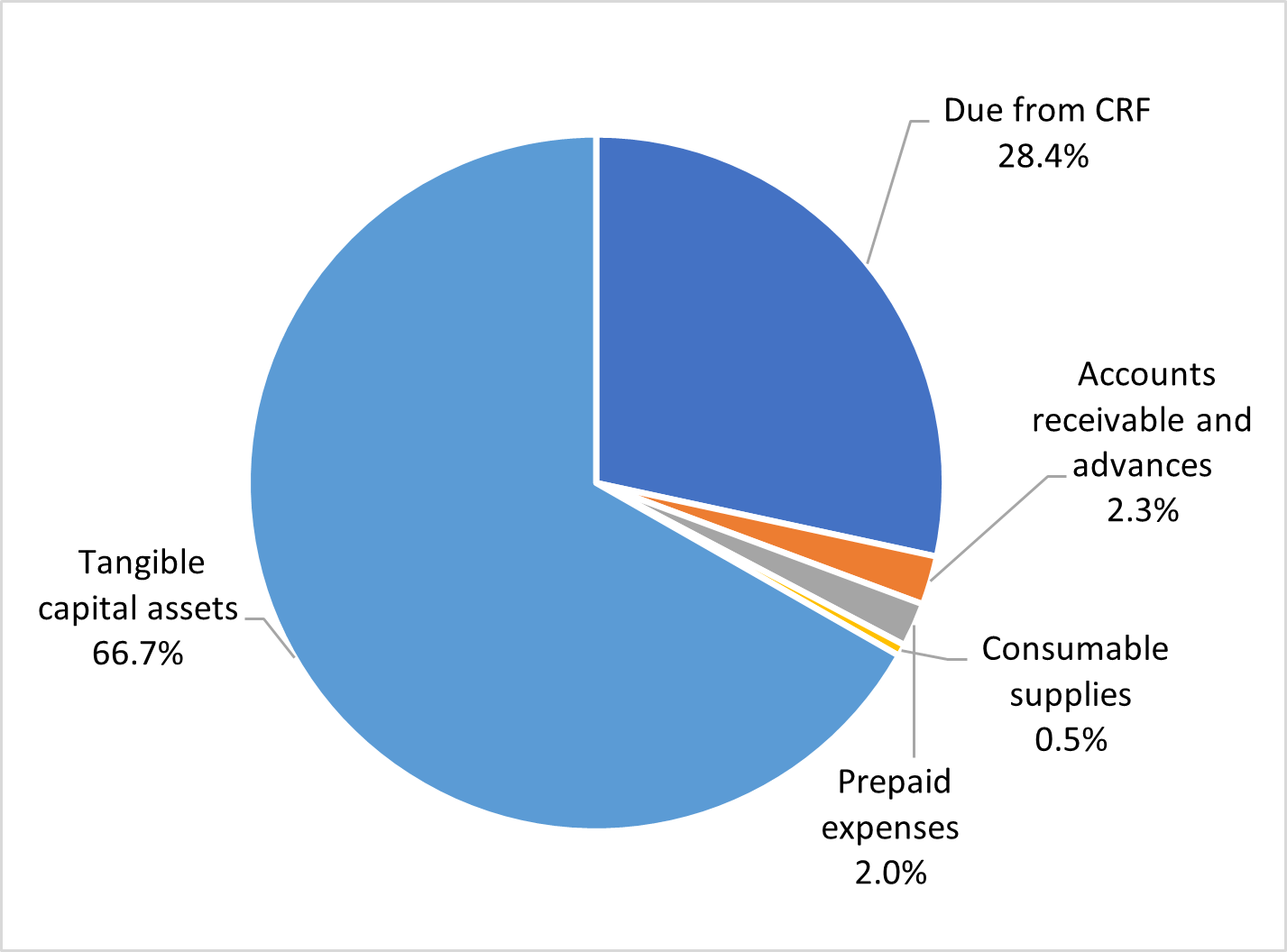
Total assets, including financial and non-financial assets, were $224.7 million at the end of 2022–23. Tangible capital assets represented the largest portion of assets, at $150 million (66.7%). They consisted of informatics software ($111 million), software under development ($24.4 million), leasehold improvements ($13.3 million) and other assets ($1.3 million). The remaining portion comprised $63.8 million (28.4%) for amounts due from the Consolidated Revenue Fund, $4.6 million (2.0%) for prepaid expenses, $5.1 million (2.3%) for accounts receivable and advances, and $1.2 million (0.5%) for consumable supplies.
Liabilities by type
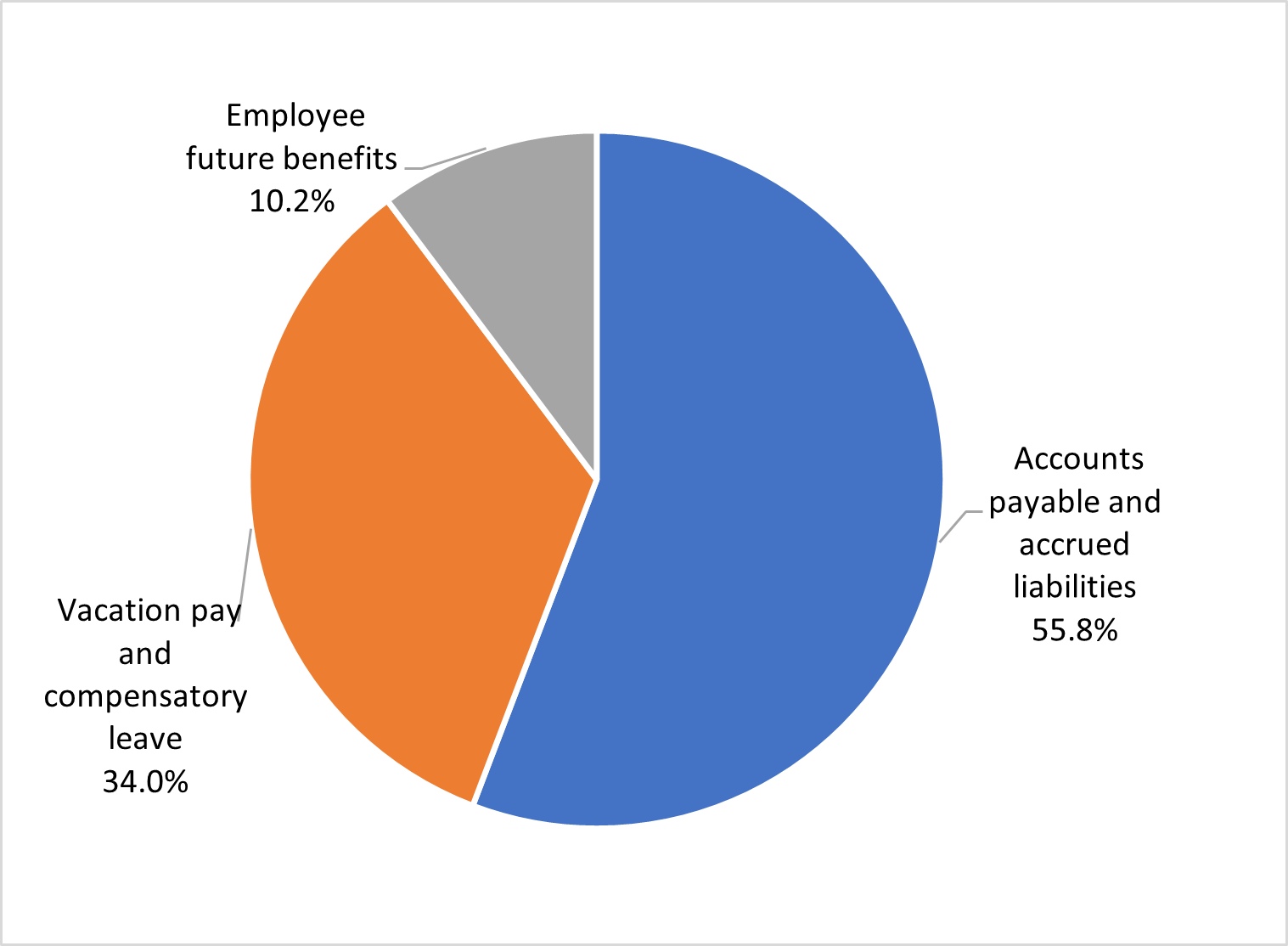
Total liabilities were $143.7 million at the end of 2022–23. Accounts payable and accrued liabilities made up the largest portion of liabilities, at $80.1 million (55.8%). They consisted of accounts payable to external parties ($24.1 million), accounts payable to other federal government departments and agencies ($18.5 million), and accrued salaries and wages ($37.5 million). The next-largest portion was vacation pay and compensatory leave, at $48.8 million (34.0%), while employee future benefits made up $14.8 million (10.2%).